There’s something about the taste of childhood foods that lingers in the back of our minds. A single bite can take you back to summers spent running through sprinklers or to cozy mornings before school. But what happens when those familiar flavors don’t match the memories? Many foods we grew up loving seem to have changed—owing to evolving recipes, cost-cutting measures, and even shifts in our own taste buds. Here’s a look at some of the nostalgic foods that just don’t taste the way they used to.
Fruit Juice

Credit: pixabay
Remember when a carton of fruit juice actually tasted like fresh-picked oranges or ripe apples? If you’re wondering whatever happened to that, it’s not just your imagination—brands have reformulated recipes over the years to prioritize shelf life over taste. Thus. most of juices now are loaded with added sugars and artificial flavors, which lacks that natural zing.
Canned Spaghetti Sauce

Credit: pixabay
Grandma’s spaghetti might still be a Sunday favorite, but canned sauces don’t pack the same punch they used to. Changes in ingredients—think less olive oil and more preservatives—have dulled the rich, bold flavors. Many brands now aim to cater to “healthier” preferences, but sometimes, that trade-off just doesn’t seem worth it.
Breakfast Cereals

Credit: pixabay
Once upon a time, breakfast was all about colorful, sugary cereals that made milk taste like dessert. Most boxes on the shelves now are toned down to meet stricter health standards. Sure, less sugar is a good thing, but the result often feels like a muted version of what used to be a treat worth waking up for.
Chocolate Bars

Credit: pixabay
Some long-time fans of chocolates, like Cadbury or Hershey’s argue that the chocolate doesn’t taste quite as creamy or rich any more. Speculations are that it’s due to recipe tweaks or sourcing different cocoa beans; but in any case, something has shifted. Even the texture feels less velvety to some.
Snack Cakes

Credit: pexels
Twinkies, HoHos, or Little Debbie’s brownies—if you grew up on these, you might notice they don’t hit the same sweet spot anymore. Many manufacturers have reduced trans fats and adjusted recipes to appeal to modern dietary concerns. The result is a texture that’s often drier and a flavor that feels like it’s missing something.
Fast-Food Favorites

Credit: pixabay
Fast food nostalgia is real, but some menu classics like McDonald’s Snack Wraps or Taco Bell’s Mexican Pizza aren’t the same when they make a comeback. Chains often adjust recipes to meet new regulations or appeal to changing tastes, which leaves loyal fans longing for the old flavors they grew up loving.
Soda

Credit: pixabay
Soda used to be an unapologetically sweet indulgence. Over the years, changes like switching from sugar to high-fructose corn syrup—or even artificial sweeteners—have given many sodas a distinctly different flavor. Even long-time favorites like Coke and Pepsi seem to have lost a bit of their fizz, at least in terms of taste.
Instant Noodles

Credit: pexels
Instant noodles were the ultimate comfort food for a quick dinner or late-night snack. But if you’ve tried them recently, you might notice a less robust flavor in the seasoning packets or a difference in the texture of the noodles. This is primarily due to modified recipes to cut sodium and appeal to health-conscious buyers.
Ice Cream Treats

Credit: pixabay
Back in the day, it was common to find the ice cream aisle once filled with gems like Nestle’s Smarties Push-Ups or novelty bars that felt like mini celebrations. Many of those classics have disappeared, and the ones that remain have changed. Subtle shifts in recipes or the use of cheaper ingredients can leave the texture less creamy and the flavor less indulgent.
Condiments

Credit: pixabay
Ketchup, mayonnaise, and mustard may still be staples, but their taste has evolved significantly. Many brands have reduced salt and sugar or removed artificial preservatives. While these adjustments align with cleaner eating trends, they’ve left condiment lovers wondering where the bold, tangy flavors went.
Packaged Cookies

Credit: pexels
The store-bought cookies of our childhood—Oreo, Chips Ahoy, or Fig Newtons—often feel like they’ve lost their magic. Health-driven recipe changes have reduced fats and artificial ingredients, but the result can be cookies that are slightly less chewy, buttery, or satisfying.
Frozen Dinners

Credit: pixabay
TV dinners once promised hearty, indulgent comfort food in minutes. Now, with recipes adjusted for lower calories and sodium, they sometimes taste more like compromise than nostalgia. The creamy mashed potatoes or rich gravies you remember may have given way to lighter but less flavorful versions.
Candy Bars

Credit: pixabay
Perhaps the most obvious shift in the snack industry is the reducing size of candy bars. But apart from their size, they also lack the sweetness or richness that they once you used to have. This is mostly due to the addition of cost-cuttingn measures like more fillers and fewer premium ingredients.
Chewing Gum

Credit: flickr
Chewing gum used to come with long-lasting flavor. Modern gums have veered toward sugar-free formulas and chemical sweeteners, often at the cost of taste. The satisfying burst of flavor that lasted for hours is now more likely to fizzle out in minutes.
Breakfast Pastries

Credit: pexels
Less filling, fewer sprinkles, or thinner icing layers are just some of the changes you may have noticed in the iconic breakfast options like Pop-Tarts and toaster strudels.. The pastry-to-filling ratio that once felt perfect can now seem slightly off.





